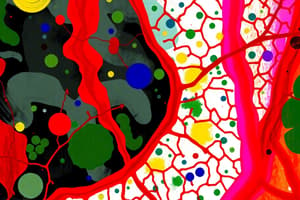Podcast
Questions and Answers
What is the primary function of microvilli in cells?
What is the primary function of microvilli in cells?
- To synthesize proteins for cellular function
- To provide structural support for the cell
- To regulate the flow of materials into the cell
- To increase the surface area for absorption (correct)
Which of the following statements accurately describes the relationship between microvilli and absorptive capacity?
Which of the following statements accurately describes the relationship between microvilli and absorptive capacity?
- The presence of microvilli is inversely proportional to the cell's absorptive capacity.
- Cells with tall, closely packed microvilli have a higher absorptive capacity than cells with short, irregular microvilli. (correct)
- Cells with short, irregular microvilli have a higher absorptive capacity than cells with tall, closely packed microvilli.
- The number and shape of microvilli do not influence a cell's absorptive capacity.
What is the structural basis for the motile nature of cilia and flagella?
What is the structural basis for the motile nature of cilia and flagella?
- Microtubules (correct)
- Actin filaments
- Collagen fibers
- Intermediate filaments
Which of the following cell junctions is responsible for preventing the flow of materials between cells?
Which of the following cell junctions is responsible for preventing the flow of materials between cells?
Which of the following proteins is primarily involved in the formation of tight junctions?
Which of the following proteins is primarily involved in the formation of tight junctions?
Which of the following cell junctions is responsible for providing strong adhesion between cells?
Which of the following cell junctions is responsible for providing strong adhesion between cells?
Which of the following cell junctions allows for communication between adjacent cells?
Which of the following cell junctions allows for communication between adjacent cells?
What is the correct order of cell junctions from the apical to the basal ends of a cell?
What is the correct order of cell junctions from the apical to the basal ends of a cell?
What is the primary function of tight junctions in epithelial tissues?
What is the primary function of tight junctions in epithelial tissues?
Which type of cell junction is primarily responsible for cell-to-cell communication?
Which type of cell junction is primarily responsible for cell-to-cell communication?
Which of the following is NOT a function of anchoring junctions?
Which of the following is NOT a function of anchoring junctions?
What is the primary protein involved in the formation of anchoring junctions?
What is the primary protein involved in the formation of anchoring junctions?
Which type of cell junction is involved in the attachment of epithelial cells to the basal lamina?
Which type of cell junction is involved in the attachment of epithelial cells to the basal lamina?
What is the role of the nuclear pore complexes in the context of cell junctions?
What is the role of the nuclear pore complexes in the context of cell junctions?
What is the main difference between desmosomes and hemidesmosomes?
What is the main difference between desmosomes and hemidesmosomes?
Which of the following statements accurately describes the arrangement of cell junctions from apical to basal ends of epithelial cells?
Which of the following statements accurately describes the arrangement of cell junctions from apical to basal ends of epithelial cells?
What function does the cell membrane primarily serve regarding ion concentration?
What function does the cell membrane primarily serve regarding ion concentration?
Which of the following correctly describes phagocytosis?
Which of the following correctly describes phagocytosis?
Which type of endocytosis involves the detachment of receptors from the membrane?
Which type of endocytosis involves the detachment of receptors from the membrane?
What is the main outcome of exocytosis?
What is the main outcome of exocytosis?
The fluid mosaic model describes the cell membrane as having a structure characterized by what two main components?
The fluid mosaic model describes the cell membrane as having a structure characterized by what two main components?
What are microvilli primarily associated with in the apical domain?
What are microvilli primarily associated with in the apical domain?
Which process is specifically characterized as 'cell drinking'?
Which process is specifically characterized as 'cell drinking'?
What role do receptors play in the receptor mediated endocytosis process?
What role do receptors play in the receptor mediated endocytosis process?
Flashcards are hidden until you start studying
Study Notes
Chromatin and Nuclear Structure
- Participates in chromatin organization and anchors nuclear pore complexes.
Cell Junctions Overview
- Composed of multiprotein complexes facilitating contact between neighboring cells or with the extracellular matrix.
- Critical for intercellular adhesion and communication, especially prominent in epithelial tissues.
Intercellular Adhesion Functions
- Tight (occluding) junctions prevent material flow between cells; formed by occludin proteins.
- Anchoring junctions (adhering junctions) provide adhesion and do not hinder material passage; rely on cadherin proteins.
- Gap junctions facilitate communication between adjacent cells, constructed from connexin proteins.
- Junction types arranged from apical to basal: Tight junctions → Adhering junctions → Desmosomes → Gap junctions → Hemidesmosomes.
Types of Anchoring Junctions
- Desmosomes: Points of attachment between cells, anchored to intermediate filaments.
- Hemidesmosomes: Bind epithelial cells to the basal lamina, containing integrins instead of cadherins.
Cell Membrane Characteristics
- Exhibits a fluid mosaic appearance due to the lipid bilayer and embedded proteins.
Cell Membrane Functions
- Acts as a selective barrier regulating ion concentration and maintaining intracellular environment.
- Performs specific recognition and regulatory functions.
- Facilitates cell interactions, including adhesion and signaling.
Endocytosis Mechanisms
- Phagocytosis ("cell eating"): WBCs like macrophages engulf and digest materials (e.g., bacteria).
- Pinocytosis ("cell drinking"): Small particles are taken into the cell, forming vesicles that break down within lysosomes.
- Receptor-mediated endocytosis: Cells absorb specific substances via inward budding of vesicles with receptor proteins.
Exocytosis Process
- Vesicles fuse with the plasma membrane to release contents into the extracellular space without compromising membrane integrity.
Cell Surface Specialization
Apical Domain
- Microvilli: Projections increasing surface area, crucial for absorption. Height and shape relate to absorptive capacity.
- Stereocilia: Long immotile microvilli found in the epididymis and inner ear, aiding absorption.
- Cilia and Flagella: Motile structures with a microtubule core (9+2 pattern), cilia primarily sweep fluids across cell surfaces.
Lateral Domain
- Tight junctions maintain barriers to fluid flow.
- Adhering junctions strengthen cell layers and stabilizing junctions beneath tight junctions.
- Organizes junctions from the apical to basal ends: Tight junctions → Adhering junctions → Desmosomes → Gap junctions → Hemidesmosomes.
Studying That Suits You
Use AI to generate personalized quizzes and flashcards to suit your learning preferences.




